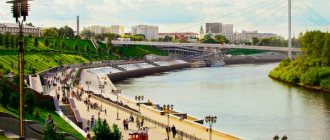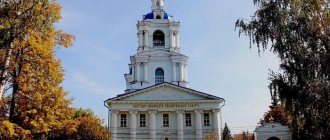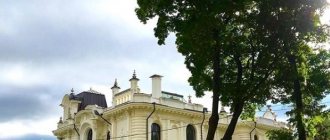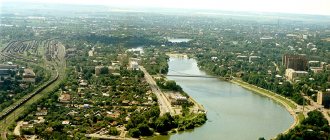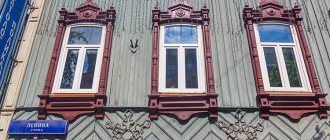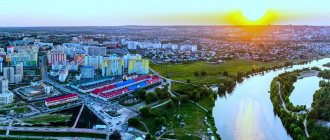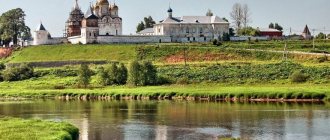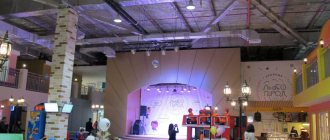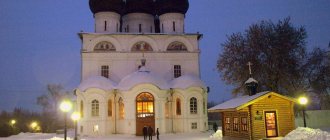According to tradition, a list of what, in the opinion of local residents, a guest of Tyumen who visits the city for the first time must do:
- Take an evening walk along the embankment of the Tura River from the Holy Trinity Monastery to the Chelyuskintsev Bridge and admire the sunsets.
“Tree of Happiness”
© Anna KudryavtsevaTake
a selfie on the Lovers' Bridge.- Relax in Tyumen thermal springs .
- Listen to music in the evening at the “Seasons” fountain on Tsvetnoy Boulevard and admire its changing lighting.
- Walk along the “Golden Line” of Tyumen, get acquainted with wooden architecture and the peculiarities of Tyumen carving.
- Get a storm of positive emotions at the LetoLeto water park by going down one of the most extreme slides, the Bermuda Triangle, with friends.
- Get acquainted with the life of merchants of the 19th century at the Masharov House museum .
- Take a boat ride along Tura and admire the views of the city from the water.
- Taste unique local cuisine at the Chum restaurant. By the way, taste all this under the shadow of a real Khanty chum, there is one there too.
- Bring your friends a souvenir with real Tyumen oil or a can of Neft vodka as a gift to your beloved boss.
About the city
Surgut. Panorama of the city | Surgut , a city in the Russian Federation, Khanty-Mansiysk Autonomous Okrug, is located in the north of Western Siberia, on the right bank of the river. Ob, 10 km from the railway station of the same name, 250 km east of Khanty-Mansiysk, 708 km northeast of Tyumen. Port (the most important in the Ob region). Airport. District center. Population 276.6 thousand people (2001). Founded in 1593. City since 1965. |
Large center of the oil industry (Salym field). Main enterprises: OJSC “Surgutneftegas”, “Tyumenenergo”. , stabilization of condensate, motor fuel. Enterprises of the food (fish canning) industry. Production of building materials (MP "Surgutzhilstroyindustriya", OJSC "Large-panel housing construction"). Surgutskaya GRES-1 and GRES-2. The Varieganskoye gas and oil field is located 20 km northeast of Surgut.
One of the first Russian cities in Siberia. Founded on the site of the Ostyak fortress. In the 17th-18th centuries. - one of the centers of Russian colonization of Western Siberia. From the end of the 18th century. district town, in 1804-1867 - a village, did not have the status of a city. Since 1868 it has been a city again. In 1926, due to the small population, it was transformed into a village. Since 1930 in the Khanty-Mansiysk National Okrug. With the discovery of rich oil and gas fields in the 1950s and 60s, Surgut began to grow rapidly. Since 1965 it has been a city again.
Educational and cultural institutions: Surgut State University, Surgut State Pedagogical Institute, International Business College "Planet", faculty of Tyumen State Oil and Gas University, branch of the Capital Humanitarian Institute, branch of Tyumen State University. Museum of Local Lore. 20 km west of Surgut, on the right elevated bank of the Ob, there is the archaeological site of Barsova Gora (60 settlements, 3 thousand dwellings, burial grounds, sanctuaries, the oldest of which date back to the Stone Age).
Question answer
Which cities in Siberia have airports?
In all those included in the top 8 rating of this article. Even in Tobolsk with a population of 100 thousand, a new Remezov airport opened in September 2022. Now you can get to the tiny but beautiful Siberian town from Moscow and St. Petersburg.
Which Siberian cities are considered the most touristic?
Of the above - Irkutsk, Tomsk and Tobolsk. Tour operators, in the wake of the development of domestic tourism, are actively promoting Novosibirsk and Tyumen (including regional attractions). Krasnoyarsk, Kemerovo and Omsk are visited exclusively for tourism purposes only by true fans.
Nizhnevartovsk
The coat of arms of Nizhnevartovsk was adopted on June 21, 1999. In the upper golden field there is a pipe with oil flowing out of it, in the silver field there is a green spruce; in an azure field there are two silver fish (symbolizing the wealth of the Ob River).
Nizhnevartovsk Panorama of the city | Nizhnevartovsk , a city in the Russian Federation, Khanty-Mansi Autonomous Okrug, is located in the north of Western Siberia, within the Central Ob Lowland, on the right bank of the river. Ob, 625 km east of Khanty-Mansiysk, 940 km northeast of Tyumen. River port. Railroad station. Airport. District center. Population 234.8 thousand people (2001). Founded in 1909. City since 1972. | One of the residential areas of Nizhnevartovsk |
The organizational and economic center of a large oil and gas producing region. Main enterprises: OJSC Nizhnevartovskneftegaz, Sibneftegazpererabotka, Chernogorneft. 3 departments of drilling operations, department of main oil pipelines. Automobile repair plant. Production of building materials. Food industry enterprises: dairy, sausage factories, bakeries, fisheries, poultry farms, etc. Timber industry. Nizhnevartovsk is the beginning of the oil pipelines Samotlor - Almetyevsk, Samotlor - Samara, Samotlor - Aleksandrovskoye.
Founded as a wood wharf in Nizhnevartovsk. On the contrary, on the left bank of the Ob, at that time there was the village of Vartovskoye, which in 1929 was included in the village of Vampugolsk. The rapid development of the village of Nizhnevartovskoye began with the opening in the early 1960s. and the development of oil fields (the largest is Samotlorskoye, others are Varyoganskoye, Khokhryakovskoye, Mykhpayskoye, Ershovskoye). Since 1964, the urban-type settlement of Nizhnevartovsky. City of Nizhnevartovsk since 1972.
The city has museums: local history, modern fine arts.
Educational institutions: Nizhnevartovsk State Pedagogical Institute, faculty of Tyumen State Oil and Gas University, branch of the Institute of International Law and Economics named after A. S. Griboyedov, branch of Tyumen State University.
Vacation with children
In Tyumen there is a sufficient amount of entertainment on a wide variety of topics for children. A win-win option at any time of the year is Tsvetnoy Boulevard , a favorite vacation spot for city residents.
Attractions on Tsvetnoy Boulevard
© Anna Kudryavtseva
There are more than four dozen different attractions for different age categories: children's, family and extreme, as well as various entertainment events, concerts, and children's games and competitions. An excellent option is a circus, a place where a child can touch something unusual. The Tyumen Circus is located here, on Tsvetnoy Boulevard.
Your child will benefit from a trip to the City Duma Museum , where a little tourist can get acquainted with the animal world of the region, see the skeletons of a mammoth and cave bear, stuffed animals and birds, and schoolchildren will benefit from the knowledge gained in the Historical Park “Russia - My History” , because Such museums exist only in large cities of the country.
You can introduce your child to the world of art by attending performances at the Puppet Theater or the Tyumen Bolshoi Drama Theater , where the repertoire includes musicals for the whole family: “The Snow Queen”, “The Adventures of Pinocchio”, “The Frog Princess”.
Active children can be entertained in extreme parks, climbing walls, trampoline centers and rope parks. Children's holidays are organized in large shopping centers. Atmosfera family amusement park in the Tyumen City Mall shopping center is a rope park, trampolines, a unique labyrinth with a giant space slide that three people can go down, a tubing slide and a spiral slide, trampolines, a nerf area for exciting blaster shooting , fanwalls where you can feel like a real climber, and much more.
Tyumen Puppet Theater
© Anna Kudryavtseva
a children's active recreation park "Corn" in the Premier shopping center, a laser tag and paintball club Ernandes Military in the Arbat shopping center, a children's park in TSUM, a children's active recreation park "Khlop Top" in the Yuzhny shopping center, a children's sports and playground KidsCity in the shopping center "Goodwin", "Third Planet" in the shopping center "Favorite" and the list is not limited to this.
One of the most popular entertainment centers in Tyumen is the LetoLeto , where you can relax with the whole family at any time of the year, even with small children. Let's not forget about boat trips around Tura; this can become an unforgettable summer adventure for your child.
More information about all the interesting places where you can relax with children in the article Where to go with children in Tyumen
Yalutorovsk
Yalutorovsk , in the Tyumen region, regional subordination, district center, 75 km southeast of Tyumen. Located in Western Siberia, on the left bank of the river. Tobol (tributary of the Irtysh). Railway station on the Tyumen - Omsk line. Population 37.0 thousand people (1992; 3.5 thousand in 1897; 5.7 thousand 1926; 13.6 thousand in 1939; 20.2 thousand in 1959; 33.4 thousand in 1979). Founded in 1639 as the fort Yalutorskaya Sloboda on the site of the Tatar settlement Yavlu-Tur. In 1782 the fort was transformed into the district town of Yalutorovsk, Tobolsk governorship. By the beginning of the 20th century. Yalutorovsk was built up with wooden houses, there were 2 churches, 4 educational institutions, Gostiny Dvor were opened; there were no factories and factories, trade was only of local importance. In the 19th century the city was a place of political exile; Decembrists N.V. Basargin, M.M. Muravyov-Apostol, E.P. Obolensky, I.I. Pushchin, I.D. Yakushkin lived in a settlement here. In modern Yalutorovsk: software for the dairy canning industry, a meat processing plant; factories for the repair of agricultural machinery, sawmills, and reinforced concrete products. Museum of the Decembrists (in the house where Muravyov-Apostol lived); The building where Yakushkin and his comrades created the first girls’ school in Siberia has been preserved.
Tyumen bus stations
The bus station in Tyumen is located at st. Permyakova, 9, next to the large shopping complex "Fair" and a branch of the higher educational institution MIGUP. To get to the bus station building you need to use city public transport or a taxi. The bus station is open from 4:00 to 22:00, seven days a week.
Regular buses travel to the following destinations: Asbest, Bishkek, Vagai, Yekaterinburg, Golovina, Ishim, Kostanay, Kurgan, Magnitogorsk, Nizhnevartovsk, Omsk, Petropavlovsk, Tobolsk, Khanty-Mansiysk.
Tobolsk
Tobolsk , in the Tyumen region, regional subordination, regional center, 247 km northeast of Tyumen. Located in the center of Western Siberia. Port on the Irtysh, near the confluence of the river. Tobol, 14 km from the railway station of the same name on the Tyumen - Surgut line. Airport. Population 97.6 thousand people (1992; 20.4 thousand in 1897; 18.2 thousand in 1926; 32 thousand in 1939; 36 thousand in 1959; 62.5 thousand in 1979). Founded in 1587 by a detachment of Cossacks of Danila Chulkov near the so-called Chuvash Cape, where on October 23, 1582, a decisive battle took place between Ermak’s detachment and the army of the Tatar Khan Kuchum (a memorial obelisk to Ermak was installed in the park on Cape Chukman, 1835-39, architect A.P. Bryullov, height 16 m). In 1587, a wooden fort was built on the so-called Trinity Cape, which later became the core of a stone Kremlin, the first in Siberia. Until 1590 it was administratively subordinate to Tyumen. In 1590 it received city status. In 1600 it was moved to Cape Chukman. In 1606-09 a wooden log city was rebuilt. In 1643, 1677, 1680 it was completely destroyed by fires. From the end of the 16th century. until the 18th century - the main military-administrative, political and church (the Siberian Diocese was established in 1620) center of Siberia. T. was also a distribution and customs center, a point of transit trade between Europe and China (it also traded with Bukhara), and a place for collecting yasak; There were numerous tanneries, forges, and an arms factory. From 1708 - a city, the center of the Siberian province, stretching from the Urals to the Pacific Ocean, from 1782 - the Tobolsk governorship, in 1796-1917 - the center of the Tobolsk province. In 1773-74 it was a stronghold of the government in the suppression of the Peasant War in the Urals and Trans-Urals under the leadership of E. I. Pugachev. In the 19th century Due to the movement of trade routes and then the construction of a railway (away from the city), the economic importance of T. fell somewhat. By the end of the 19th century. in T. there were 2,332 houses (including 50 stone ones), there were 25 churches and the Znamensky Monastery, 15 educational institutions, 177 trade shops, a city museum, several printing houses were opened, and 48 factories and factories operated. The main occupation of the residents was fishing and processing fish, which was salted, dried, and frozen in winter and sent to Irbit, Yekaterinburg, Moscow, and St. Petersburg. Furriery (up to 1 million squirrel skins, as well as hare and fox skins) and mitten (sewing mittens from suede) trades were also developed. During the period of the XVII - early XX centuries. T. was the largest cultural, educational and educational center of Siberia: chronicles were written here, the first Slavic-Russian school in Siberia was opened in 1703, a theater was founded in 1705, a printing house operated, and the first Siberian magazine “The Irtysh Turning into Ipokrena” was published. In many ways, the cultural significance of T. was determined by the activities of exiles: in the 17th century. - Slavic publicist Yu. Krizhanich and archpriest Avvakum, in the 18th-19th centuries. — A. N. Radishcheva, P. A. Sumarokova, V. V. Passek; in the 30-50s. XIX century - Decembrists A.P. Baryatinsky, brothers P.S. and N.S. Bobrishchev-Pushkin, F.B. Wolf, S.G. Krasnokutsky, V.K. Kuchelbecker, A.N. Muravyov, P.N. Svistunov, I.A. Annenkov, N.A. Chizhov, S.M. Semenov, F.M. Bashmakov, M.A. Fonvizin (the memorial houses of Muravyov, Svistunov and Fonvizin have been preserved) and V.I. Shteingel. The composer A. A. Alyabyev, the scientist D. I. Mendeleev, the architect A. F. Kokorinov, the artist V. G. Perov, the cartographer, architect and historian S. U. Remezov were born in T., the artist V. I. lived and worked Surikov, poet and teacher P. P. Ershov (his house has been preserved; a sculptural monument was erected at the Zavalny cemetery), historian of Siberia P. A. Slovtsov, poet D. P. Davydov, musician N. Ya. Afanasyev, Ukrainian poet P. A. Grabovsky. In Tbilisi, from August 1917 to April 1918, the last Russian Emperor Nicholas II and his family were under arrest. Leading enterprises of modern T.: petrochemical plant, shipyard and ship repair plant, biofactory; wood processing plant, furniture, carpet weaving factories, enterprises for the production of building materials, food industry. T. is one of the centers of the Russian bone-carving craft, which has existed since the second half of the 19th century. (the first workshop of I. E. Oveshkov was opened in 1877); in T. - a factory for artistic bone carving (established in 1960 on the basis of the Tobolsk Bone Carver artel, founded in 1932), where they make boxes with relief ornaments, inlays and engravings, brooches, multi-figure compositions (round tabletop sculpture with miniature compositions of a genre nature ). Pedagogical Institute named after D.I. Mendeleev, branch of Kazan Technological University. In 1989, the only theological seminary in Siberia reopened in the city, and in 1990 the Tobolsk-Tyumen diocese was formed. Drama Theater named after P. P. Ershov. State Historical and Architectural Museum-Reserve (founded in 1870; until 1961 - Museum of Local Lore; now one of the largest in Siberia, over 200 thousand exhibits; rich archaeological and ethnographic collections, a collection of objects of decorative and applied arts, paintings, sculptures of Siberia and T .). The city is located in a bend of the river. Irtysh, on steep coastal slopes and the vast lowland of its right bank. The appearance of the city is determined by the dominant position of the stone Kremlin (late 17th - late 19th centuries) with large-scale religious and civil buildings standing on a high plateau and surrounded by walls with towers and battlements (the walls and several towers were restored in the 1970s-80s according to the project architect F. G. Dubrovin). The cult and church-administrative eastern part (the so-called Sophia courtyard), which made up the 1st stage of the stone construction of the Kremlin (1680-90s, architects G. Sharypin and G. Tyutin), is formed by: the most ancient stone structure of Siberia - the majestic the 5-domed Sophia-Assumption Cathedral (1681-86) with an emphatically geometric main volume and various decorative elements (in the interior there are paintings of the 1720-30s, presumably by St. Petersburg painters R. and I. Nikitin, the tomb of the first Siberian hierarchs); cathedral sacristy (1796-97); the main high-rise dominant of T. is the cathedral bell tower (1794-97, designed by architects A. Guchev and F. Utkin, height 75 m) with an 8-sided dome and rusticated corners; Baroque Intercession Cathedral (1743-46, expanded in 1850); 3-storey bishop's house (1773-75; now the Museum of Local Lore) in the style of classicism; 2-story Consistory (1787); the stone belfry of the “Uglich” bell, “exiled” to T. during the reign of Boris Godunov, and other buildings. At the 2nd stage of the construction of the Kremlin (1700-17, architect S. U. Remezov), its secular part, the so-called Small or Voznesensky city, was rebuilt: the Prikaznaya Chamber (1700, in the 1780s built into the 3-story palace of the governor) ; Gostiny (Menovoy) courtyard (1703-05) with an internal closed courtyard, 2 gates and 4 towers with battlements; Renteria, or Treasury (also “Swedish Chamber”; 1714-16, from the end of the 18th century - archive); in the same part there are Public Places (1828-31, designed by the St. Petersburg architect D. Visconti, including part of the governor’s palace, 1782, burned down in 1788). The main longitudinal highways of the northern, mountainous parts of Tashkent and the southern (the so-called lower city), as well as several radial streets, are oriented towards the Kremlin. The development of T. is of a regular nature, developed in the master plans of 1767 and 1784. In certain areas of the city, sections of earlier, free, picturesque buildings have been preserved, which constitute the special originality of T. The panorama of the mountainous part in the old T. is determined by the Spasskaya Church (1709-13) and the church Peter and Paul (1768-88, bell tower - 1807). Outside the old city, behind an earthen rampart with the remains of a ditch, in the Zavalny cemetery, there is the Church of the Seven Youths of Ephesus (1776) with rounded corners and rusticated pilasters. The high-altitude landmark of the foothill, commercial part of the city, which determined the riverine perspective of T., was the Znamensky Monastery (founded in 1596, on the modern site - from 1623), from which a 2-story cell building (1734-41) with the Kazan Church in the eastern end has been preserved (finished in 1768, the lower tier survived), the bell tower (1768, part of the quadrangle remained) near the western wall, the seminary building (1870s). To the east of the monastery, among the wooden buildings, there is a tiered, “octagon-on-quadrangle” type Church of the Nativity of the Virgin Mary (1744-61) with a bell tower on the basement. On the southern outskirts of T., in the former Cossack settlement, there are the baroque St. Andrew's Church (1744-59) and the 2-story, 5-domed (originally 9-domed) Church of the Exaltation of the Cross (1754-1771, interiors with rich decorative stucco molding - 1789) with a bell tower topped with a spire (1778-80). On one of the two main thoroughfares of the lower city, the former Pyatnitskaya Street, built up mainly with small wooden houses, there is the Church of Paraskeva Pyatnitsa (begun in 1762, classicism) and the Church of Zechariah and Elizabeth (1759-76, being restored), one of the best Baroque monuments in Siberia; to the east of it is the Church of Michael the Archangel (1745-54, built by the Tobolsk coachmen Cherepanovs), 2-tier, with an external entrance, with rich facade decoration and a baroque openwork fence. Civil buildings in the Baroque style: merchant magistrate (mid-1750s), similar in form to early Petrine architecture; Bogoroditskaya (Bogoyavlenskaya; after the name of the church dismantled in the 1930s) almshouse near the Kurdyumka river under the mountain. Monuments of private stone construction in T. of the second half of the 18th century: Khudyakov’s house (late 1750s) with baroque architraves on the 2nd floor; 2-storey house of the Volodimirovs (late 1760s, after 1788 - a government pharmacy) with elegant facades in the style of Peter the Great’s Baroque; provincial gymnasium (until 1788, rebuilt in 1824, originally the Korniliev house, then the residence of the governor and the Main Public School), garrison hospital at the earthen rampart (1776). In the center of Podgornoye T. monuments play an active role: classicist - the former house of Smorodinnikov-Dranishnikov (late 18th century) in transitional forms from baroque to classicism, the 3-story house of Severyukov (1788, rebuilt in the 1820s), 2-story house of the Governor General (1788, originally Kuklin's house); in the spirit of eclecticism and modernism - a brick church (second half of the 19th century, neo-Gothic), originally the building of the Museum of Local Lore (1887-88, pseudo-Russian style), a 2-story Kornilov mansion (now a bank, second half of the 19th century, neo-Renaissance), the former women's gymnasium (1915, late modern). In Tashkent, significant areas of wooden residential buildings from the 19th and early 20th centuries have been preserved. with 2-story houses decorated with saw carvings. Since the 1960-70s. T. was actively built up in a northern direction, along Alafeyskaya Mountain. Among the large buildings of this period, the railway station located far to the north (1974) with a long-span folded hall floor stands out. According to the master plan for the development of T., protected protected zones have been established, including the landscape surrounding the historical part of T., it is planned to create a new public center much to the north of the Kremlin, with the removal of new buildings beyond the boundaries of the old city. 8 km north of T. is the Suzgun hill with archaeological monuments - an ancient sacrificial site and the remains of a bronze foundry (circa 10th-8th centuries BC). On the Chuvash Cape south of T. there is the site of Potchevash (second half of the 1st millennium) and a burial mound of 17 mounds (IV centuries BC - 1st-2nd centuries AD). 20 km east of T., along the former Omsk postal route, behind the village of Alemasova, on the right bank of the Irtysh, near the Sibirka River, the semi-eroded Isker Hill (also Kashlyk, Siberia), the site of an ancient settlement (first quarter of the 2nd millennium) and capital of the Siberian Khanate (XVI century, excavations 1915). 12 km southeast of T., on the left bank of the Irtysh and the Shantalyk river, is the former Ioannovsky (John the Vvedensky) monastery (founded in 1653) with an empire-style cathedral (1808-12), the winter Vvedensky church at the abbot’s corps (1790 , rebuilt in 1853), 2 monastic buildings (1752, with the 2nd floor added in 1811), a quadrangular fence (1805-06) and a domed pavilion over the “Holy Well”. 30 km east of T., in the village of Preobrazhenskoye, is the Church of the Transfiguration of the Savior (1770s), the figured head of which and the end of the quadrangle are reminiscent of the Zakharyev Church in T. Not far away, on the steep left bank of the Irtysh, in the village of Abalak, the former Znamensky Monastery (from 1636 - a graveyard; monastery - from the end of the 18th century), a famous center of pilgrimage to the miraculous icon of the Abalak Mother of God: the Znamensky Cathedral (1683-91) with a heavy dome on a low octagon; Trinity Church (1748-50); bell tower with the “Holy Gate” (1752-59; height 38 m) with a gallery-promenade in the 2nd tier; stone fence (1825); residential buildings, a hotel and services (XIX century) on the sides of the extensive monastery courtyard. In the northern suburbs of T. there is the former Bishop's Grove with the remains of the country church of the Tobolsk bishop (18th century).
Ishim
Ishim , in the Tyumen region, regional subordination, district center, 319 km southeast of Tyumen. Located in Western Siberia, on the left bank of the river. Ishim (tributary of the Irtysh). Railway station on the Tyumen - Omsk line. Airport. Population 65.8 thousand people (1992; 8 thousand in 1893; 48 thousand in 1959; 56 thousand in 1970; 63 thousand in 1979). Known since 1670 as the village of Korkina. From the first quarter of the 18th century. - Korkina Sloboda, from 1782 - the city of I. By the end of the 19th century. there were 867 houses, 80 shops; There were 17 enterprises (including a steam mill; factories - a brewery, a brick factory, a soap factory, a candle factory, 4 tanneries, 4 lard factories, 2 oil mills). Every year in December, the Nikolskaya Fair was held in India, one of the largest in Western Siberia (turnover reached 10 million rubles), which attracted over 2 thousand traders of local lard, oil, leather, and furs; The main imported goods were textiles, groceries, and iron. In 1829, I. was visited by the German geographer and traveler A. Humboldt; Decembrists A.I. Odoevsky and V.I. Shteingel and writer G.A. Machtet served their exile here. Modern India is the center of an agricultural region. , mechanical engineering, building materials. Food industry enterprises (butter and cheese and meat processing plants, confectionery factory, brewery). Carpet, sewing, shoe, furniture factories. Pedagogical Institute.
ZAVODOUKOVSK , a regional center in the Tyumen region, 96 km southeast of Tyumen. Located on the river. Bolshoy Uk (tributary of the Tobol). Railway station (Zavodoukovskaya) on the Tyumen - Omsk line. Population 26.4 thousand people (1992; 21.1 thousand in 1979). Known since 1729. In 1747-50, a distillery was built in the village of Ukovskaya (existed until 1810-12). Since 1787 - the volost village of Zavodoukovskoye (about 3 thousand inhabitants), in which flour-milling, candle-making, lard-making, and tanning enterprises operated; 2 annual fairs were held. Further development is associated with the construction of the Tyumen - Omsk railway; in the early 1900s Zavodoukovskaya station arose (a station building and barracks for workers were built). In 1929-70 the timber industry enterprise functioned. Since 1941 - a workers' settlement, since 1960 - a city (since 1965 - a regional center). In modern Z. there is a machine-building plant, a mechanical forestry enterprise, and a clothing factory. Since 1961, the microdistrict near the machine-building plant was built up with 3-story houses; among the buildings of modern architecture are administrative buildings, a residential building with the Yubileiny store (all - 1965), etc. Near the west there are springs of thermal mineral waters (a hydropathic clinic).
Train Station
Tyumen railway station is located at st. Privokzalnaya, 22. The station is open 24 hours a day. On October 7, 1974, a new building was opened, which includes a luggage department, a 9-story hotel building, and ticket offices. The capacity of the waiting rooms is 1.5 thousand people per day. The number of tracks is 15, platforms are 3. There is free parking for cars nearby. The railway station was founded on December 5, 1885.
The most popular long-distance train routes: Chita, Moscow, Kazan, Volgograd, Vladivostok, St. Petersburg, Ufa, Adler, Barnaul, Ulan-Ude, Krasnoyarsk, Chita, Orenburg. Suburban trains are also serviced at the station.
